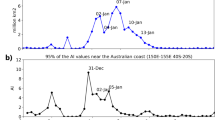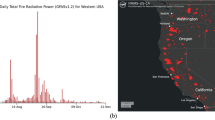Abstract
There is a possibility that severe climate perturbations would follow a major nuclear war (the ‘nuclear winter’) due to the injection of large amounts of smoke into the atmosphere1–6. Given assumptions about the amount of smoke generated, its carbon content, the size of the particles and their optical properties, calculations of the subsequent cooling of the surface air temperatures have been made with a variety of atmospheric models. It has not been possible in these models, however, to represent any effects due to the initially patchy nature of the smoke. We investigate here whether such effects could be important by using a 15-km resolution atmospheric model to simulate the mesoscale response to a single smoke plume. Our results show that vertical circulations created by the radiative heating of the smoke may be sufficiently intense to lead to cloud formation and hence to scavenging of the smoke.
This is a preview of subscription content, access via your institution
Access options
Subscribe to this journal
Receive 51 print issues and online access
$199.00 per year
only $3.90 per issue
Buy this article
- Purchase on Springer Link
- Instant access to full article PDF
Prices may be subject to local taxes which are calculated during checkout
Similar content being viewed by others
References
Turco, R. P., Toon, O. B., Ackerman, T. P., Pollack, J. B. & Sagan, C. Science 222,1283–1292 (1983).
Crutzen, P. J., Galbally, I. E. & Bruhl, C. Climatic Change 6, 323–634 (1984).
Covey, C., Schneider, S. H. & Thompson, S. L. Nature 308, 21–25 (1984).
Alexandrov, V. V. & Stenchikov, G. L. in Proc. Appl. Math., Moscow (1983).
The Effects on the Atmosphere of a Major Nuclear Exchange (National Academy Press, Washington, 1985).
Thompson, S. L. Nature 317, 35–39 (1985).
Ramaswamy, V. & Kiehl, J. T. J. geophys. Res. 90, 5597–5613 (1985).
Tapp, M. C. & White, P. W. Q. Jl R. met. Soc. 102, 277–296 (1976).
Carpenter, K. M. Q. Jl R. met. Soc. 105, 629–688 (1979).
Golding, B. W. & Machin, N. A. Proc. Nowcasting-II Symp., Norrkoping (ESA-SP 208,1984).
Slingo, A. & Schrecker, H. M. Q. Jl R. met. Soc. 108, 407–426 (1982).
McClatchey, R. A., Fenn, R. W., Selby, J. E. A., Volz, F. E. & Garing, J. S. Envir. Res. Pap. No. 411 (Air Force Cambridge Research Laboratories, Massachusetts, 1972).
Author information
Authors and Affiliations
Rights and permissions
About this article
Cite this article
Golding, B., Goldsmith, P., Machin, N. et al. Importance of local mesoscale factors in any assessment of nuclear winter. Nature 319, 301–303 (1986). https://doi.org/10.1038/319301a0
Received:
Accepted:
Issue Date:
DOI: https://doi.org/10.1038/319301a0
This article is cited by
-
Environmental effects from burning oil wells in Kuwait
Nature (1991)
-
Simulating the climatic effects of nuclear war
Nature (1988)
-
Initial uncertainties in ?nuclear winter?: A proposed test based on the dresden firestorm
Climatic Change (1988)
-
The mesoscale effects of nuclear winter
Nature (1986)
-
Uncertainties in the smoke source term for ‘nuclear winter’ studies
Nature (1986)
Comments
By submitting a comment you agree to abide by our Terms and Community Guidelines. If you find something abusive or that does not comply with our terms or guidelines please flag it as inappropriate.



